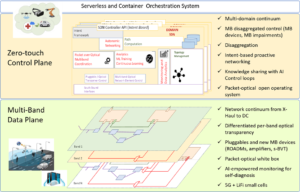B5G-OPEN key innovations

The beyond 5G transmission scenario requires new and cost/power-effective solutions for mid/long term evolution while preserving the growing capacity per optical interfaces and cards.
Under the Beyond 5G paradigm (i.e., beyond first focused and standalone 5G trials), the network should be capable of supporting massive small cell deployments, as well as the widespread end-to-end (E2E) support to heterogeneous use cases with considerably different requirements in terms of connectivity, latency and reliability.
The H2020 European Project ”Beyond 5G – OPtical nEtwork coNtinuum (B5G-OPEN)” focuses on the innovative technologies enabling the mid/long term evolution towards beyond 5G scenario from the perspective of the end-to-end optical transport infrastructure.
- A Multi-Band (MB) optical transport network infrastructure, based on specifically designed MB node architectures, MB switching, MB amplification, and MB transmission solutions, cost-effectively addressing the 10× bandwidth increase, providing open and fast programmability, and enabling an E2E continuum that drastically reduces optical to electrical conversion and digital packet elaboration across network segments as for example enabled by point-to-multipoint (P2MP) optical transmission realized by employing digital subcarrier multiplexing.
- A MB low-latency optical X-haul infrastructure exploiting coherent pluggable-based P2MP heterogeneous solutions to enable massive small cell deployments (e.g., including innovative LiFi small-cells) through its integration within the transport infrastructure and the support of Quality of Service (QoS)-guaranteed services (e.g., in case of mobility).
- A modular zero-touch control plane, capable of orchestrating services across the E2E underlying infrastructure, jointly optimizing the packet and MB optical layers, while ensuring scalability and reliability, targeting zero-touch operations and relying on cluster-based distributed systems that synchronize state and exchange Machine Learning (ML) models.
- A massive telemetry system for data collection supporting intent-based autonomous networking and intelligent network operations through Artificial Intelligence (AI) and ML algorithms.
